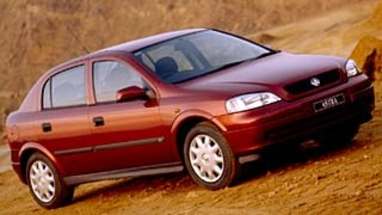Used Holden Astra review: 1996-1998
By Graham Smith · 23 Jan 2009
After a number of unsuccessful attempts to market small cars drawn from other car makers Holden turned to its Euro cousins for what has become a rip-roaring success in the form of the German-designed Astra. The Astra badge was a part of the Holden range before the arrival of the European Astra in 1996, but they were rebadged Nissan Pulsars produced under an arrangement with the Japanese car maker who was the building the Pulsar locally.Holden later turned to Toyota under the doomed joint venture between the two companies and sold rebadged Corollas as Holden Novas for a while, but that ended when the deal went sour.Both deals were struck in times of trouble when Holden was in effect a one-car car company struggling to stay afloat in an increasingly competitive local market in the 1980s, but those days are a fast fading memory and Holden is forging ahead like never before in its history with a range of models that virtually covers the whole market.The Astra was already successful before it arrived on these shores, being the second best selling small car in Europe behind the VW Golf at the time. Those early Astras, designed in Germany, were built in England by Vauxhall, which was sensible really given that the Brits drive on the same side of the road as we do.At launch Holden offered two body styles, a four-door sedan and a five-door hatch, but there were three levels of trim and equipment which was enough to suit just about everyone’s needs.The entry level model was the City 1.6, which was available in both body styles. The mid-range model was the GL 1.8, which was also available in both body styles, while the range-topping model was the sporty GSi 2.0 that was only available as a hatchback and came with a sexy Zender body kit.Inside, the Astra was roomy with plenty of space for four adults and luggage. Rear seat room was particularly praised by road testers at the time of release, as was its luggage carrying capacity, which was boosted by a 60/40 split-fold rear seat.Power for the Astra came from a range of four-cylinder engines, all adapted to local conditions by Holden’s engineers, and featuring multipoint fuel-injection.The base engine in the City was a 1.6-litre single overhead camshaft four-cylinder engine that produced 74 kW at 5800 rpm and 135 Nm at 3400 rpm, which delivered a blend of performance and economy.A 1.8-litre four-cylinder engine powered the GL. This one was produced by Holden in Australia, and boasted twin overhead camshafts with four valves per cylinder. Peak power was 85 kW at 5400 rpm and maximum torque was 165 Nm at 4000 rpm.The sporty GSi packed the biggest punch in the range. With twin cams, and 16-valves, it put out 100 kW at 5600 rpm and 188 Nm at 3200 rpm.City and GL buyers could choose between a five-speed manual gearbox and four-speed electronic auto, which was a $1950 option, but the only choice for those signing up for the hot GSi was the five-speed manual.Under the Euro skin lay a well proven suspension arrangement with MacPherson Struts complete with gas-filled shocks at the front, and compound torsion beam axle at the rear with progressive rate coil springs and gas shocks at the rear.Spring rates, shock settings and the diameter of the stabiliser bar were optimised for each engine variant.Power steering was standard across the range, with the GSi getting a faster rack for a sharper feel.Brakes were a combination of front discs and rear drums on the City. The GL and GSi boasted four wheel discs, and the GSi had the added benefit of standard ABS.Inside there was attractive fabric trim, a multifunction display, and a locally developed Eurovox six speaker sound system. The GSi also had sports seats, a leather-wrapped steering wheel, and power front windows.Standard equipment included a driver’s side airbag, an immobiliser, and central locking although it couldn’t be activated remotely. Missing from the features list was an adjustable steering column.On top of those features the GSi also boasted a passenger’s side airbag as standard and a security alarm.The options list included a passenger’s side airbag for the City and GL, and air-conditioning.The Astra was criticised for its high level of noise and vibration, which reflected its lower refinement than was being offered by the benchmark Japanese cars at the time.The manual trans gearshift was thought rubbery and imprecise, but the Astra’s overall ride and handling was praised, as was its steering, which was direct and well modulated.Being three years old when it arrived here the Astra was trailing the competition a little when launched, but was still regarded as a good small car choice that offered good interior room with plenty of performance while still returning admirable economy.Reports from the trade suggest the Astra is robust and reliable with few problems with the engine or transmission.One complaint often heard is the rate of wear of the brakes. The Astra’s European origins should have alarm bells ringing if you’re concerned about frequently replacing brake linings and discs. Some owners report having to change disc pads at around 30,000 km and discs at 60,000 km.It’s possible to extend brake life by fitting alternative pads and discs available on the aftermarket, but you might affect your car’s braking performance in the process. Before you change it’s best to check with your local brake specialist.The Astra’s body and trim stand up well, but check carefully for signs of a crash. Check panel fit, body gaps, smooth opening of doors and hatch or boot, and paint matching. Particularly check bumpers for bumps and scrapes, taking care to check bumper mountings to make sure they are intact.Check for a service record to verify odometer reading, which on average will be between 100,000 and 130,000.• Smart European style• Roomy interior and lots of luggage space• Robust mechanical package• Relatively high brake wear










